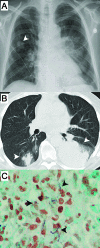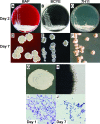Nocardia cyriacigeorgica, an emerging pathogen in the United States
- PMID: 18003809
- PMCID: PMC2224293
- DOI: 10.1128/JCM.00937-07
Nocardia cyriacigeorgica, an emerging pathogen in the United States
Abstract
Nocardia cyriacigeorgica is recognized as an emerging pathogen in many parts of the world. We present the first case description of invasive N. cyriacigeorgica pulmonary infection in the United States identified to the species level by 16S rRNA and hsp65 sequence analysis. A subsequent retrospective molecular screening of recent Nocardia clinical isolates at our New York City medical center yielded an additional six N. cyriacigeorgica isolates. Because routine laboratory algorithms for the phenotypic identification of Nocardia species are limited in practice, the true prevalence of N. cyriacigeorgica infections may be greater than currently appreciated. Indeed, we present evidence confirming that N. cyriacigeorgica is coincident with the unofficial species designation Nocardia asteroides complex antimicrobial susceptibility pattern type VI and distinct from the N. asteroides sensu stricto strain ATCC 19247(T). As nocardial species identity can predict antimicrobial susceptibility and guide clinical management, we offer simplified phenotypic and molecular protocols to assist the identification of N. cyriacigeorgica.
Figures





Comment in
-
Nocardia cyriacigeorgica--an established rather than an emerging pathogen.J Clin Microbiol. 2008 Jul;46(7):2469; author reply 2469-70. doi: 10.1128/JCM.00510-08. J Clin Microbiol. 2008. PMID: 18614666 Free PMC article. No abstract available.
References
-
- Alp, E., O. Yildiz, B. Aygen, B. Sumerkan, I. Sari, K. Koc, A. Couble, F. Laurent, P. Boiron, and M. Doganay. 2006. Disseminated nocardiosis due to unusual species: two case reports. Scand. J. Infect. Dis. 38545-548. - PubMed
-
- Ambaye, A., P. C. Kohner, P. C. Wollan, K. L. Roberts, G. D. Roberts, and F. R. Cockerill III. 1997. Comparison of agar dilution, broth microdilution, disk diffusion, E-test, and BACTEC radiometric methods for antimicrobial susceptibility testing of clinical isolates of the Nocardia asteroides complex. J. Clin. Microbiol. 35847-852. - PMC - PubMed
Publication types
MeSH terms
Substances
Associated data
- Actions
- Actions
- Actions
- Actions
- Actions
- Actions
- Actions
- Actions
- Actions
- Actions
- Actions
- Actions
- Actions
- Actions
- Actions
- Actions
LinkOut - more resources
Full Text Sources
Molecular Biology Databases
Research Materials

